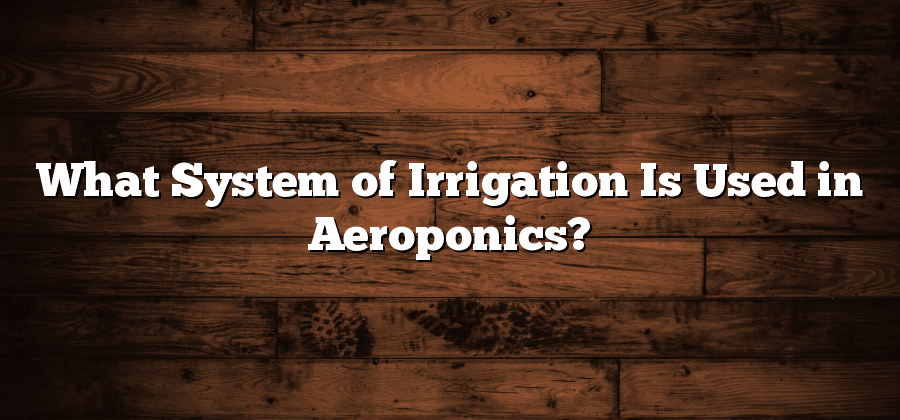Understanding Aeroponics and Its Principles
Aeroponics is an innovative method of growing plants in a soilless environment. Unlike traditional farming techniques that rely on soil or water to deliver nutrients to plants, aeroponics utilizes a misting system to provide the necessary nourishment. This cutting-edge approach offers numerous advantages over conventional farming, including increased crop yield and faster growth rates.
The principle behind aeroponics is simple yet brilliant. By suspending the plant roots in air and periodically spraying them with a nutrient-rich mist, growers can ensure that the plants receive an optimal amount of oxygen, moisture, and nutrients. This targeted delivery system promotes the efficient absorption of essential elements, allowing plants to thrive in a controlled and highly productive environment. Thanks to its versatility and effectiveness, aeroponics is gaining popularity in various sectors, from commercial agriculture to urban gardening.
The Role of Nutrient Delivery in Aeroponics
To achieve successful plant growth in aeroponics, nutrient delivery plays a crucial role. Unlike traditional soil-based methods, aeroponics relies on the delivery of essential nutrients directly to the plant roots suspended in air. This unique approach allows for optimal nutrient absorption, resulting in faster growth rates and higher yields.
In aeroponic systems, nutrient delivery is typically accomplished through a fine mist or aerosol, ensuring that the plant roots receive a consistent supply of nutrients. This precise delivery method eliminates the need for excessive watering or soil-based nutrients, reducing waste and increasing resource efficiency. By providing essential nutrients in a targeted manner, aeroponic systems promote better plant health and development, ultimately enhancing the overall success of the growing operation.
In understanding nutrient delivery in aeroponics, it is important to consider the specific nutrient requirements of the plants being cultivated. Different plant species may have varying nutrient needs, and a well-designed aeroponic system will meet these requirements by adjusting the nutrient solution accordingly. By closely monitoring and maintaining precise nutrient levels, growers can optimize plant growth, enhance nutrient absorption, and troubleshoot any nutrient deficiencies or imbalances. The ability to fine-tune nutrient delivery in aeroponics not only maximizes yields but also allows for the cultivation of a wide range of plant species with varying nutrient requirements.
Exploring the High-Pressure Aeroponic System
In the world of aeroponics, the high-pressure aeroponic system stands out as an innovative and efficient method of plant cultivation. Unlike other aeroponic systems, the high-pressure system utilizes a specially designed misting nozzle that creates a fine mist of nutrient solution. This mist is dispersed directly onto the plant’s root zone, ensuring optimal nutrient absorption and oxygenation.
One of the key advantages of the high-pressure aeroponic system is its ability to deliver nutrients at a microscopic level. The fine mist produced by the system allows for more efficient nutrient absorption through the plant’s root hairs. This not only promotes faster growth and development but also maximizes the plant’s overall nutrient uptake. Additionally, the high-pressure system ensures that every plant receives an equal amount of nutrients, resulting in uniform growth and higher crop yields.
Low-Pressure Aeroponics: A Cost-Effective Alternative
With the ever-growing demand for sustainable farming practices, aeroponics has emerged as an innovative solution. Among the different types of aeroponic systems, low-pressure aeroponics offers a cost-effective alternative that is gaining attention in the agricultural world.
Unlike high-pressure aeroponics, which relies on specialized equipment and high-energy consumption, low-pressure aeroponics uses simpler and more affordable components. The basic concept behind this system involves delivering a fine mist of nutrient-rich solution directly to the plant roots. By utilizing low-pressure pumps and spray nozzles, the system ensures an efficient and even distribution of nutrients, while minimizing water waste. This makes low-pressure aeroponics not only environmentally friendly, but also financially accessible for farmers of varying scales.
The Importance of Mist Nozzles in Aeroponic Irrigation
Mist nozzles play a critical role in the success of aeroponic irrigation systems. These specialized nozzles are designed to atomize the nutrient solution into tiny droplets, creating a fine mist that can be easily absorbed by the plant roots. The size of the droplets produced by the mist nozzles is crucial, as larger droplets may not penetrate the root zone effectively, while smaller droplets may evaporate before being absorbed. Therefore, selecting the right mist nozzles is essential to ensure optimal nutrient delivery for the plants.
One of the key advantages of mist nozzles in aeroponic irrigation is their ability to provide a uniform and efficient distribution of nutrients. With their precise and controlled spray pattern, mist nozzles can ensure that each plant receives an equal amount of the nutrient solution. This uniform distribution promotes consistent root growth and nutrient absorption, resulting in healthy and thriving plants. Additionally, mist nozzles help to minimize waste by reducing overspray and runoff, making them an environmentally friendly choice for aeroponic systems.
Overall, the importance of mist nozzles in aeroponic irrigation cannot be overstated. Their ability to create a fine mist of nutrient solution and distribute it evenly to plant roots is crucial for the success of aeroponic systems. With proper selection and maintenance of mist nozzles, growers can optimize nutrient delivery, promote healthy plant growth, and ultimately achieve higher yields in their aeroponic gardens.






